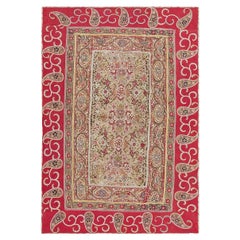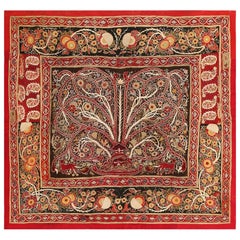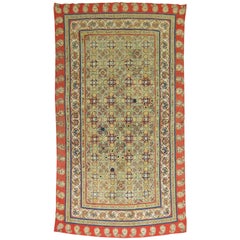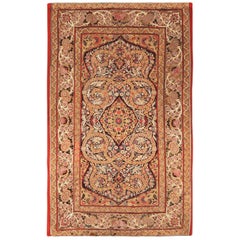Persian Textile Rashti
Antique Persian Paisley Rashti Embroidery Textile 3'10" x 5'7"
Located in New York, NY
Antique Persian Rashti Embroidery Textile, Country of Origin: Persia, Circa Date: Early 20th
Category
Early 20th Century Persian Other Persian Rugs
Materials
Wool
Antique Persian Tree of Life Design Rashti Embroidery Textile 4'4" x 5'
Located in New York, NY
A Truly Captivating Antique Persian Tree of Life Design Rashti Embroidery Textile, Country Of
Category
Antique Mid-19th Century Persian Other Persian Rugs
Materials
Silk, Wool
Zabihi Collection 19th Century Antique Persian Rashti ‘Rascht’ Embroidery
Located in New York, NY
Hand-embroidered Chain stitched persian textile made in the middle of the 20th century. Silk
Category
Antique Mid-19th Century Uzbek Victorian Pillows and Throws
Materials
Cotton, Silk
$7,000 Sale Price
20% Off
H 92 in W 55 in D 0.1 in
Antique Persian Silk Embroidery. 4 ft. 5 in x 7 ft. 5 in
Located in New York, NY
Beautifully antique Persian silk Rashti Embroidery textile 70225, country of origin: Persia, date
Category
Early 20th Century Persian Other Persian Rugs
Materials
Silk
People Also Browsed
Wonderful 19th Century Kazak Rug
Located in Chicago, IL
A wonderfully "tribal" 19th century Persian Kazak rug with boldly woven floral, vegetable and animal motifs woven in crimson, indigo, green and gold vegetable dyed wool. The border i...
Category
Antique 19th Century Azerbaijani Kazak Persian Rugs
Materials
Wool
Early 20th Century Persian Tabriz Pictorial Accent Rug
Located in New York, NY
An antique Persian Tabriz pictorial accent rug handmade during the early 20th century.
Measures: 4' 6" x 5' 11"
Persian rugs & carpets:
Persia (Iran) is a moderately large cou...
Category
Early 20th Century Persian Folk Art Persian Rugs
Materials
Wool
Bobyrug’s Rare Antique Ottoman Silk and Metal Embroidery
Located in Saint Ouen, FR
Beautiful late 19th century Turkish ottoman embroidery with nice design and green field color, entirely hand embroidered with golden metal on silk foundation.
✨✨✨
"Experience the ep...
Category
Antique Late 19th Century Turkish Islamic Tapestries
Materials
Silk
$1,148 Sale Price
20% Off
H 27.56 in W 44.1 in D 0.4 in
Low Round Ottoman / Footstool in Pure Alpaca
By Fritz Hansen, Flemming Lassen, Märta Blomstedt, Mogens Lassen, Viggo Boesen
Located in Lewes, East Sussex
An elegant, modern, low, round ottoman. Handmade in England. Newly upholstered in a premium, soft, pure alpaca wool fabric with solid oak feet. Custom sizes and fabric options a...
Category
2010s British Scandinavian Modern Ottomans and Poufs
Materials
Alpaca, Oak
12 Coalport Grey and Polychrome Enamel Floral Shaped Rim Dinner Service Plates
By Coalport Porcelain
Located in Great Barrington, MA
This set of 12 Coalport dinner plates feature an unusual color combination of a soft gray border decorated with a vibrant palette of brightly painted flowers. There are various combi...
Category
Vintage 1920s English Dinner Plates
Materials
Porcelain
$3,800 / set
H 0.75 in Dm 10.5 in
Vintage Inspired Handcrafted Fluted Farmhouse Porcelain Pendant Light
By DBO Home
Located in Sharon, CT
Classic, elegant, with a perfectly imperfect touch. We just love our new porcelain Parasol Fluted Pendants. Inspired by a vintage pie cover, we designed them to hang over our kitchen...
Category
21st Century and Contemporary American Bohemian Chandeliers and Pendants
Materials
Brass
$2,000 / item
H 8.5 in Dm 17.5 in
Antique Persian Malayer Rug
Located in Evanston, IL
Immerse yourself in the captivating world of Malayer rugs, where Turkish tribal weavers intricately wove tales of artistry. Employing the symmetrical Gourde knot, a hallmark of their...
Category
Early 20th Century Persian Malayer Persian Rugs
Materials
Wool
Tiffany & Co. Sterling Coffee of Chocolate Set with Tray
By Tiffany & Co.
Located in Litchfield, CT
Date marked 1962/63, Sterling, by Tiffany & Co., England. Modern and Art Deco collide in this very sleek coffee or chocolate set. Brilliant as a decorative accessory or perfect for ...
Category
Vintage 1960s English Sterling Silver
Materials
Sterling Silver
20th Century Italian Sterling Silver Renaissance style Entree Dish
By Arval Argenti Valenza
Located in VALENZA, IT
Renaissance-style round sterling silver entree dish.
The bottom of the entree dish is smooth, while a border made with the casting technique with acanthus leaf motifs has been welded...
Category
1990s Italian Renaissance Sterling Silver
Materials
Sterling Silver
$3,731 Sale Price
32% Off
H 5.91 in Dm 10.63 in
Ararat Rugs Dragon Rug, Antique Caucasus Museum Revival Carpet, Natural Dyed
By Ararat Rugs
Located in Tokyo, JP
There has long been a fascination with the symbolism of the dragon and its depiction in carpet weavings. The design of ‘Dragon’ carpets consists of a field pattern composed of differ...
Category
21st Century and Contemporary Caucasian Revival Caucasian Rugs
Materials
Organic Material, Natural Fiber, Wool
$8,500
W 67.33 in L 106.7 in
Late 19th Century Gilt Bronze Mounted Three Piece Sèvres Style Clock Set
Located in Long Island City, NY
Late 19th Century Gilt Bronze Mounted Three Piece Cobalt Blue Sèvres Style Clock Set
Comprising: a round clock with a final with two birds; a pair of five-light candleabra with sc...
Category
Antique 19th Century French Belle Époque Clocks
Materials
Bronze, Ormolu
$19,500 / set
H 20 in W 15 in D 10 in
Art Deco King Size French Walnut Bed, circa 1930s
Located in Devon, England
Superb and extremely glamorous 1930s Art Deco bed. Originating from France this bed boasts the most wonderful veneers. Totally original and having been through our workshops has been...
Category
Mid-20th Century French Art Deco Beds and Bed Frames
Materials
Walnut
Woven Legends Rug with Natural Dyes Hand Knotted
Located in Lohr, Bavaria, DE
Woven Legends Rug with Natural Dyes Hand Knotted
A large Azeri rug with traditional design in style of Malayer or Bidjar The pile is made of high-end quality wool - hand spun, hand ...
Category
Late 20th Century Turkish Heriz Serapi Turkish Rugs
Materials
Wool, Cotton
Josef Hoffmann and the Wiener Werkstaette Fabric Department Pendant, Re-Edition
By Woka Lamps, Wiener Werkstätte, Josef Hoffmann
Located in Vienna, AT
A simple but sensational fixture, designed by Josef Hoffmann, for the fabric department of the Wiener Werkstaette on Kaerntnerstrasse in Vienna. Style and color of the fabric custom-...
Category
2010s Austrian Jugendstil Chandeliers and Pendants
Materials
Silk
$6,458 / item
H 39.38 in Dm 37.41 in
Zabihi Collection 20th Century Turkish Slithering Snake Anatolian Rug
Located in New York, NY
A mid 20th Century Turkish Rug depicting 2 slithering snakes on an ivory field
Details
rug no. r5744
size 4' 3" x 6' (130 x 183 cm)
Category
Mid-20th Century Persian Folk Art Persian Rugs
Materials
Wool
Mid-Century Modern Cube or Case Club Lounge Chairs
By Milo Baughman, Edward Wormley
Located in Philadelphia, PA
A very high quality matching pair of club chairs, circa 1970s. Completely restored with brand new upholstery.
Category
Vintage 1970s American Mid-Century Modern Club Chairs
Materials
Fabric, Wood
Get Updated with New Arrivals
Save "Persian Textile Rashti", and we’ll notify you when there are new listings in this category.
More Ways To Browse
Milan Metelak
Ming Dogs
Ming Dynasty Portraits
Ming Dynasty Roof Tile
Minton Moon Vase
Minton Pedestal
Minton Porcelain Ball
Mirror Clad Cabinet
Mode Desk
Modern Adirondack Chair
Modern Nubby Chair
Modern Vertical Wall Art
Modigliani Head
Modular Shelving Metal Wood
Modular Wall Desk
Mogens Koch Wingback Chair
Molgaard Fd146
Monastery Statue



